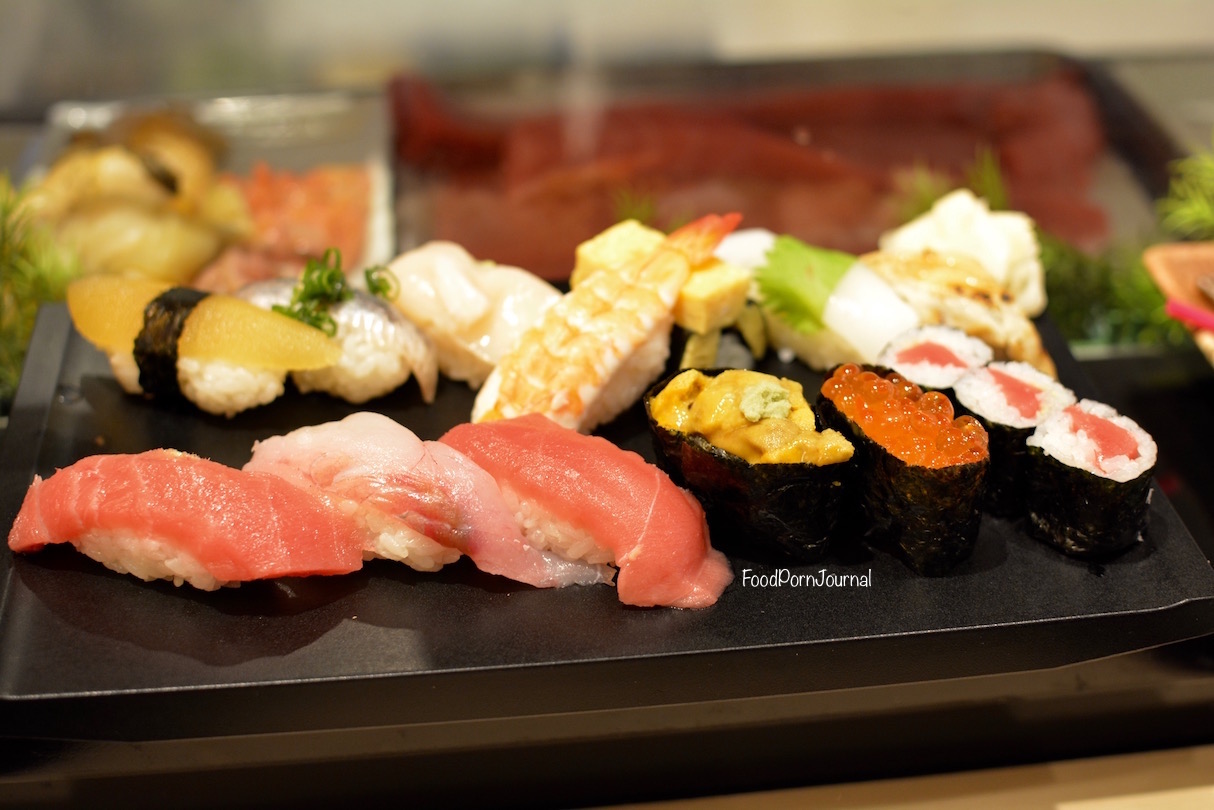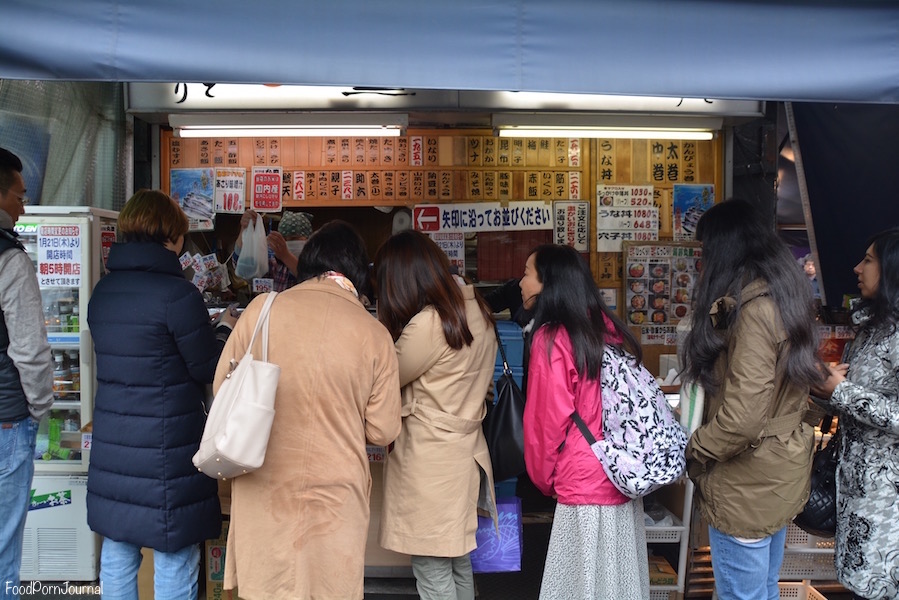When my sister asked me if wanted to travel to Japan together to check out the cherry blossoms, it didn’t take long to convince me to say yes. Japan was never high on my priority list of places to visit, but the opportunity arose and I took it. We spent a month there and it was a jam packed trip. There was so much I wanted to eat but I only have one stomach. I’m attempting to write about everything I ate but I’ll break it down into several posts. Our first stop was Tokyo.
The first thing we did when we got in and dropped off our bags, was head straight to the Tsukiji Markets, one of the largest fish markets in the world. Tripadvisor, other travel sites and friends all say to get to the fish market early (3am early) to line up and put your name on a list to view the tuna auctions that take place (they only take 60 people for each of the two sessions), but neither of us were interested in the auction or getting up that early. Plus I really just wanted to wander around and eat whatever grabbed me. The markets were so busy and it took a bit of maneuvering to get through all the people, but it’s all part of the experience!

We stuck to the outer market area where there was plenty of fresh seafood that could be bought from the many stalls.

I had done a little bit of research on what to eat at the markets, but I decided to try whatever caught my fancy. I also learnt that if there is a queue for something, you should definitely join! I remembered reading about Sushi Zanmai, which had a small queue (at about 11am) but my sister and I were happy to join the queue. It was only a 15 minute wait until we got two seats at the counter. A low glass display counter runs the length of the bench where you can see the different cuts of fish and other seafood. It was great watching the chefs work quickly and consistently. Each person had their own ‘station’ or specialty – one person slicing the various sashimi, another rolling the Japanese rice into balls so that another could place the thinly sliced sashimi on top.

I chose the uruoi sushimori special (¥1980 or AUD$24) which came with 13 different pieces of sushi. With the fish bought daily straight from the fish markets a few metres away, the sashimi is as fresh as you can possibly get it. Delicious thickly cut sashimi and good portions. It also came with a side of miso soup.

My sister isn’t actually a raw fish kind of gal, so she stuck with the cooked foods. She wasn’t that hungry either so she ordered the crab soup and some grilled fish (I’ve forgotten the cost of these). She regretted ordering the crab soup as it was very messy and hard work to crack the shell for very little meat.

The grilled fish had been cooked to perfection – so smooth and juicy.

I loved walking around the markets to see what else I could discover. Kind of like being a kid in a candy store. We walked past a few stalls selling strawberry daifuku. These are strawberries sitting on large mochi stuffed with a sweet filling. Mochi are Japanese rice cakes made out of glutinous rice so they have a nice sticky gelatinous texture.

What caught my eye was that some of the strawberries were white! Not full on white white, you can see that they were more of a light shade of pinky white. I bought one white strawberry mochi (¥500) or AUD $6) to try. These were more expensive than the regular red strawberries (¥300), as they would take a bit of skill to grow. The strawberry was sweet and juicy, and tasted like a regular strawberry if you were to close your eyes. The mochi was fresh, soft and filled with a bit of red bean paste. Yum!

A packet of the white strawberries alone were ¥5000 (AUD$60!). Fruit in general in Japan is so expensive!

This little baby watermelon was (¥2500 or about AUD$30).

There were so many stalls tucked away in little alleyways and corridors.

Most with just 4 or 5 stools, and a queue of people waiting for their turn. Definitely not somewhere you can take your time to eat and chat. Eat quickly so that the next person can have their turn. I passed by a few oyster stands selling freshly shucked oysters – these were huge!

I saw a massive queue at a stall and had to get onto my tip toes to see what the stall was actually selling. The main item was freshly made onigiri, so I joined the queue.

As it was about 10am, most of the good stuff had sold out and there wasn’t much of a selection. The onigiri I chose consisted of curried rice which was still warm. I love Japanese rice! It was a good choice for that chilly morning. I found it difficult finding a breakfast spot in Japan, so I would often go to the 7 Eleven, Lawson’s or other convenience store for their freshly made sushi. As I can’t read Japanese, it was always a surprise what flavour I had picked! Convenience store sushi is pretty darn good but with minimal filling. Great value for around AUD$1.50-$2 each. If you need to stick to a tight budget, you could probably live off these for a few days.

We also passed a corner shop, Tsukugon,which as been around for about 140 years selling all sorts of hot fried foods. Best of all, they had English translations on the signs!

There were so many things I wanted to try, but after having that onigiri, I settled on one steamed and seasoned fish cake wrapped in bacon. It was a tad oily but oh-so-good. Plain fish cake, no spiciness, with a bit saltiness from the bacon.

We were lucky enough to visit the Tsukiji Markets twice, however both visits were very short as we had to keep moving on to fit in all our sightseeing. After looking at the market map, I found out that we had only explored a quarter of the outer-market area! I’ll definitely plan more time at the markets for my next trip there.
Tips
- It’s okay to take a small backpack, but don’t drag a suitcase around the markets. The place is so packed!
- Get there early so you don’t miss out on certain foods and have the option of joining the queues before they get too long.
- Give yourself plenty of time to enjoy the various stalls and food on offer.
- Markets are closed Sundays and some Wednesday’s. Best to check the market calendar.
Useful websites
- The Tsukiji Market map to find out where certain stalls were actually located. Click on the link to the English guide map.
- The Tsukiji Market website with the market calendar.
- Japan Guide provides general information on what to expect and do’s and don’ts.
- I also found Boutique Japan useful in planning my outing to the markets.
- Timeout‘s Top 15 snacks at the Tsukiji markets were a good read of what to try. As most stalls don’t have an English sign, I found it difficult figuring out where a stall was located. This was a common issue throughout the trip where I’d read about something fantastic but then not be able to find it. I’ll need a Japanese food guide next time 🙂
Next up is Eating in Tokyo – Part 2 – Shibuya and Harajuku.
If you want more random photos and updates about food, I’m on Facebook, Twitter and Instagram
Facebook: /foodpornjournal
Twitter: @foodpornjournal
Instagram: /foodpornjournal
